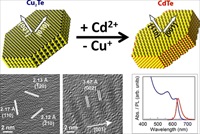Members Login

Channels
Special Offers & Promotions
Photoluminescence Evaluation of Colloidal CdTe Quantum Disks
Researchers at the Istituto Italiano di Tecnologia, Genova and IMEM-CNR have used the FLS920 photoluminescence spectrometer from Edinburgh Instruments to measure the photoluminescence (PL) spectral properties.
 Researchers at the Istituto Italiano di Tecnologia, Genova and IMEM-CNR, Parma in Italy have used the FLS920 photoluminescence spectrometer from Edinburgh Instruments to measure the photoluminescence (PL) spectral properties, quantum efficiencies and lifetimes of novel CdTe semiconductor quantum disks, synthesized from disk-shaped Cu2Te nanocrystals.
Researchers at the Istituto Italiano di Tecnologia, Genova and IMEM-CNR, Parma in Italy have used the FLS920 photoluminescence spectrometer from Edinburgh Instruments to measure the photoluminescence (PL) spectral properties, quantum efficiencies and lifetimes of novel CdTe semiconductor quantum disks, synthesized from disk-shaped Cu2Te nanocrystals.
Fluorescent nanocrystals are currently being applied in lasers or displays, and offer exciting prospects for future photonics such as quantum emitters. The nanocrystal shape plays an important role in these applications. The flat CdTe quantum disks with high fluorescence efficiency therefore provide an interesting possibility to explore the shape- and crystal structure-dependent fluorescence properties of semiconductor nanocrystals.
The measurements conditions could be carefully controlled using the FLS920: the PL quantum efficiency of the CdTe quantum disks was measured with an integrating sphere, by exciting the samples at 500 nm. Band-edge PL lifetime measurements were made with the FLS920 using time-correlated single-photon counting, exciting the samples at 400 nm with a 50 ps laser diode. The repetition rate of the diode was adjusted to 1 MHz to ensure complete decay of the emission between subsequent excitation pulses.
The disks show a PL peak that can be tuned continuously from 600 to 640 nm according to their thickness. The researchers also reached a faster PL decay time compared to spherical CdTe quantum dots, which confirms that simply tuning the shape can strongly improve conditions for lasing or single-photon emission. In addition, the current synthesis also leads to more stable nanocrystals compared to conventional preparation methods, opening up the way for practical application of the quantum dots. The results were recently published in the Journal of the American Chemical Society.
more about Edinburgh Instruments
Media Partners


